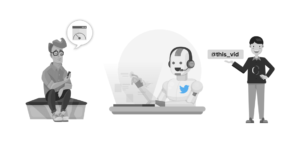How To Choose The Right Tech Stack For Your Product?

How many times has technology boggled you? While you are an expert at using technology, choosing the right tech infrastructure for your business has never been your cup of tea. Choosing between Python and Java, when suiting up your technology infrastructure, has always given you a headache. However, as a stakeholder, you are asked to do it every once too often, and you simply cannot avoid it.
There are different database architectures and software solutions, and you are not too aware of the differences, and you don’t really know which hosting solution should you opt for.
These questions and the task of choosing one out of many has slowed down your operations, and has taken your mind away from running the core business. What will you do now? How will you be able to solve this riddle that takes away much of your time?
To start with, we will help you choose the right tech stack for your product. No, we won’t be choosing it for you but, we will help you with the tips that should do the work for you.
Know the project requirements
It all starts with the type of project you are dealing with, and the basic project requirements. If you are dealing with a small project, you may need to deliver it at the earliest. For accelerated development, you can use simple and user-friendly technologies such as WordPress or other CMS. This technology works when you need to deliver a working prototype as soon as possible.
For mid-level project requirements, you may want to use a combination of programming languages which will introduce multiple features and functionality in the software solution. The technology should be such that it can be seamlessly integrated into the different platforms. This would include technologies such as Java or C#.
Finally, for the complex projects, you should choose a combination of several programming languages and web technologies. The choice of technology and language would depend on the size of the project as well as the business goals. For instance, if your goal is to process heavy loads, you might want to use programming languages and frameworks that are meant for this purpose. If low latency is your goal, then there are frameworks that tend to reduce the latency and improve the application’s responsiveness.
Introduce agility
Adding up technology to your stack but, not having a quality product can ruin your chances of success. You should make sure your product is good enough and has a market.
It is important to validate the product before you move on with the technology stack. So, go simple. Either create a static landing page on
or WordPress to introduce your product and the problem you are solving. Once validated, start with the basic feature. Introduce features, one at a time, for the best results. Make sure you monitor the progress real-time. As development is agile, you may be able to change the direction of the project as per the need and the feedback received.
You need to minimize the risks, which means you will need to consider the features that are necessary to realize the product and make sure it turns into a success.
Go beyond project requirement
While you need to consider the project requirement, you also need to consider the other requirements of your business such as users, speed, migration etc. We will discuss each point in detail for you to make the right choice.
- Users: The product is ultimately built for the users. The choice of the technology depends on a whole load of factors including user experience and the target audience. Who is going to use the system? How will they access the system- via tablets or mobile devices or laptops? Finally, how many concurrent users are you looking at? The technology stack will depend on the answers to these questions.
- The speed and performance: Loading times can be quite a thing to deal with. If you are developing a system from the scratch, you can avoid looking at performance. You can always build the system, and once you have reached a certain user level, you can work on optimizing the performance. This way you won’t delay going out to the market, and your system will be agile and so will the technology stack.
- Migration: Do you have an existing system or database that needs to be migrated? Do you have legacy systems that need to be integrated or transferred to the new system? When you are choosing the technology stack, these things need to be considered.
- Security concerns: You can never ignore the security needs when choosing the technology stack. Your technology solution should be secure. It is also important that you choose a stack that your resources are competent with or can be learnt easily, is secure and complies to your policies.
Expertise and knowledge of your team
As we briefly discussed earlier, it is important you choose a technology stack that your resources are comfortable with and know how to use. You should consider your team’s expertise with the various technology stacks available. The expertise will play a role in not just implementing the code but also in getting the system out in the market at the earliest. Once the app has been launched, the developer team is responsible for maintaining the system.
The idea is to choose a technology stack that has a good community support and vendor support. Github is an excellent place to know which tech-stack has a good community support.
Choose technologies that can be tested easily, and are suited for the test-driven development environments. This is best for the systems wherein you will be testing while the development is in progress to make sure your changes are agile and you can go to the market at the earliest.
The team should be able and an expert in dealing with the TDD environment.
Again, the vendor support is something you need to look into when choosing the tech stack. Which companies are involved in the development of the technology? For instance, you can rely on Angular, as Google is involved in its development.
Check the main technology webpage to see how the updates are handled and how the updating or migration process occurs?
Flexibility & Scalability
How fast and how good can the website handle work? This is what scalability tests. The system should be able to handle the growing number of users, the concurrent load and that too without affecting the performance of the system.
When you are choosing a technology stack, make sure you choose it while keeping the future needs of the app in mind, whether the system grows horizontally or vertically. Horizontal scaling is when you need to add servers to handle the influx of traffic while, vertical scaling is when you need to add new programs to process the new data added to the system.
The technology stack would be used for at least the next 10 years. In the current time, the technology evolves and matures in a period of few years, and we are looking at a longer period. You may want to choose a stack that will stay with you over the period you are considering. It is important you separate the backend from the frontends and the services when you are choosing the technology stack. Concepts like service oriented design and domain-driven design might help you in the longer run.
The development cost
The final factor that helps in choosing the right technology stack would be the development cost. While, the open source technologies are available for free, there are other licensed technologies that need you to pay for using it.
When it comes to devising a new software solution, it is important you know what you are dealing with, and how much you are willing to spend for the same. The cost of development should be in sync with the usability and performance of the technology stack in consideration.
Apart from the technology cost, there is also the developer salary that you need to consider before choosing the stack for development. If you want to cut down on the cost of development, it is better if you choose an open source technology stack.
Summing up
It is important that you know how much and what kind of resources it takes to maintain a new system. This will help in deducing the hiring costs, the expertise needed, and whether the technology will suit your needs.
As a stakeholder, you should be part of the important decision. However, if you believe that you cannot take it alone, you can always partner with us. As your technology partner, Coruscate will not only involve you in the process of taking technology decisions but also educate you with why we are going with the stack. We believe collaborative decisions and making life easy for you.
If you have an idea or want to rebuild an existing system, connect with us via email or phone.





